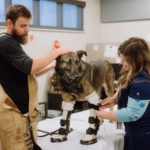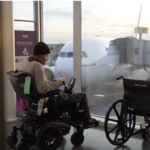Pediatricians get new guidance on Cerebral palsy
A pair of major health organizations are issuing new guidance to doctors about how to identify children with cerebral palsy and appropriately treat the condition.

Emily Pineda, who has cerebral palsy, walks with the help of pediatric physical therapist Kandis Jones and Trexo Plus, a robotic walking aid. April Gamiz, The Morning Call TNS
by Michelle Diament, Disability Scoop November 28, 2022
In a clinical report and an executive summary published online this month in the journal Pediatrics, the American Academy of Pediatrics (AAP), and the American Academy for Cerebral Palsy and Developmental Medicine (AACPDM), said it’s critical for kids to be screened and identified early to ensure the best outcomes.
Children who are at risk for cerebral palsy due to preterm birth or other medical history should be closely monitored for motor problems, the guidance indicates. But, the medical groups note that many kids with cerebral palsy have no identifiable risks from birth and need to be identified through screening and surveillance.
With that in mind, the American Academy of Pediatrics recommends that all children participate in standardized developmental screenings at ages 9, 18 and 30 months, including a neuromotor examination to assess various milestones and muscle tone, according to the report.
Children diagnosed with cerebral palsy benefit from a multidisciplinary approach with a team of medical and health specialists ranging from their primary care physician to physical, occupational and speech therapists, the guidance states.
Pediatricians should be on the lookout for common co-occurring conditions in those with cerebral palsy including issues with cognition and learning, speech and language, behavior and mental health, epilepsy, sensory impairments, pulmonary problems, sleep issues, nutrition, growth and gastrointestinal troubles, orthopedic complications and more. If kids with the developmental disability experience new symptoms or functional declines, physicians should fully investigate the changes without assuming that they are the result of cerebral palsy, the medical groups said.
“It really does ‘take a village’ to help children with CP reach their full potential,” said Dr. Garey Noritz, lead author of the report and chairperson of the American Academy of Pediatrics Council on Children With Disabilities (COCWD). “Families and physicians share this goal and can partner to improve quality of life by focusing on the strengths of the child and family, providing appropriate services and adapting the environment to the needs of each child.”
| About the author |
| Michelle Diament is a seasoned journalist whose work has appeared in People, AARP, The Washington Post Magazine, The Chronicle of Higher Education and Gannett News Service. As the sibling of an adult with autism, Diament is no stranger to the world of disability issues. She holds a degree in journalism and political science from the University of Wisconsin-Madison. |
Source Disability Scoop
| References |
Providing a Primary Care Medical Home for Children and Youth With Cerebral Palsy, Garey Noritz, Lynn Davidson, Katherine Steingass, The Council on Children with Disabilities, The American Academy For Cerebral Palsy And Developmental Medicine, The Council on Children with Disabilities, The American Academy For Cerebral Palsy And Developmental Medicine. Pediatrics 2022; e2022060055. 10.1542/peds.2022-060055. Full text, PDF
Executive Summary: Providing a Primary Care Medical Home for Children and Youth With Cerebral Palsy, Garey Noritz, Lynn Davidson, Katherine Steingass; The Council on Children With Disabilities, and The American Academy For Cerebral Palsy And Developmental Medicine, Pediatrics 2022; e2022060056. 10.1542/peds.2022-060056. Full text, PDF
| Further reading |
Providing a Primary Care Medical Home for Children and Youth With Cerebral Palsy, Gregory S. Liptak, Nancy A. Murphy, The Council on Children With Disabilities; Pediatrics November 2011; 128 (5): e1321–e1329. 10.1542/peds.2011-1468. Full text, PDF
Also see
Caring for patients with cerebral palsy: Report highlights key guidance for pediatricians AAP News
Early Detection of Cerebral Palsy American Academy for Cerebral Palsy and Developmental Medicine
Identifying Cerebral Palsy Early Can Help Children Thrive American Academy of Pediatrics
Cerebral Palsy in Children American Academy of Pediatrics






